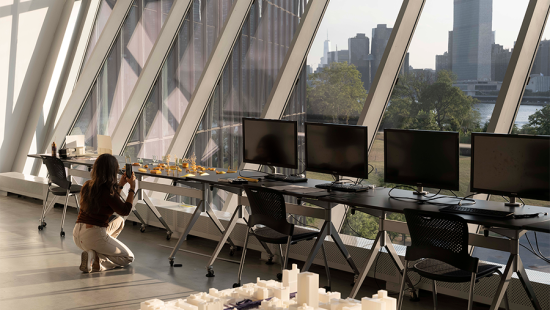Real Time: A Symposium on the Architecture of Packets, Pixels, and Neurons
From realtime visualization in video games to realtime urban monitoring, advances in computer, communication, and media technologies offer exciting new possibilities while raising urgent questions for architecture, planning, and digital studies. The second Preston Thomas Memorial Symposium at Cornell AAP this spring invites artists, designers, and scholars to explore them.

image / MTWTF
How, and for what purpose, are cities and populations tracked, virtualized, and simulated by computational infrastructures in realtime? The semester's second Preston Thomas Memorial Symposium — "Real Time," organized by Assistant Professor of Architecture Farzin Lotfi-Jam with coordination by Design Teaching Fellow Ekin Erar — will take up this critical question and more on April 13 in Milstein Auditorium at Cornell's College of Architecture, Art, and Planning (AAP), examining applications across and beyond military, entertainment, and urban contexts.
"You could say that realtime is the dream vision of technocratic management — a state of total omniscience, where what is known and how it is known is flattened onto the glistening surface of the computer screen," says Lotfi-Jam, whose research is rooted in evolving realtime urbanism. "The realtime paradigm is equally a response to consumer demands for convenience and speed as much as it is a reaction to government and corporate appetites for rich and frequent renderings of information. But realtime is not just about deploying speed to minimize costs and increase margins. It is also about designing for an emerging market of experiences. New human-to-machine interfaces allow more intuitive interactions with spatial information and digital processes — from the scale of the smart city to the optimized home."
While this offers immense potential, Lotfi-Jam also raises concerns around the convergence of military and entertainment tools, as well as the fact that marginalized communities and migratory populations are often targets of realtime surveillance and containment. On his research, Lotfi-Jam notes, "I wanted to know what it meant that my profession, its design tools, and its metrics for productivity are shaped by this realtime military logic."
Three Panels, Three Big Questions
An international roster of panelists will address major questions in this discursive space.
Panel 1 — Liveness: What is the value and creative possibility of instantaneity in an era of on-demand media entertainment, digital asset libraries, and persistent virtual worlds?
Panel 2 — Fidelity: What is the role of temporal and spatial resolution in the production of informational authority?
Panel 3 — Transmissions: What histories, presents, and future imaginaries are allowed and foreclosed by regimes of record collecting?
In addition, a keynote address delivered by Shaka McGlotten, Professor of Media Studies and Anthropology and Chair of the Gender Studies and Global Black Studies Programs at Purchase College–SUNY, will explore computational hexes, and digital doppelgängers.
Step Inside a Realtime System
On view in the John Hartell Gallery April 13–20, the companion exhibition, A Recursive History of Urban Simulation, presents an episodic history of urban simulation. The exhibition will feature a catalog of computational concepts and their implementations, including virtual humans, synthetic populations, and digital twins. The installation itself is a realtime system: visitors will be live streamed into a virtual world and can interact with an urban simulation produced based on historical research.
The Takeaway
Against a backdrop of thrilling massive-scale virtual events and refrigerators that can monitor their own inventory, it is vital to carefully examine the effects of these technologies. Lotfi-Jam explains that "by bringing together artists, designers, and scholars, the symposium asks if it's possible to disassemble the uneven architectures of realtime, and in their place, reassemble more ethical and equitable computational concepts of space, time, and being — to advocate for practices of realtime computation, communication, and media production that allow for more just and exciting spatial and temporal orders."







